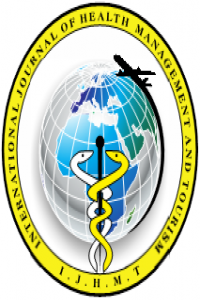MODELING OF ACCESS TO HEALTH SERVICES IN TURKEY: THE COUNT DATA MODELS WITH A POISSON DISTRIBUTION
MODELING OF ACCESS TO HEALTH SERVICES IN TURKEY: THE COUNT DATA MODELS WITH A POISSON DISTRIBUTION
access, health the count data models, healthcare management,
___
- Akaike, H. (1973). Information Theory and an Extension of the Maximum Likelihood Principle. In B. N. Petrov, & F. Csaki (Eds.), Proceedings of the 2nd International Symposium on Information Theory (pp. 267-281). Budapest: Akademiai Kiado
- Cameron, A.C., Trivedi, P. K. (1998). Regression Analysis of Count Data, Cambridge University Press, United Kingdom. Committee on Economic, Social and Cultural Rights. The right to the highest attainable standard of health: 11/08/2000. E/C.12/2000/4, CESCR General Comment 14. Twenty-second session Geneva, 25 April–12 May 2000 Agenda item 3
- Donabedian A. (1972). Models for organising the delivery of personal health services and criteria for evaluating them. Milbank Memorial Fund Quarterly 1972; 50: 103–154
- Frost, L. J. and Reich. M. R. (2008). Access- How do good health technologies get to poor people in poor countries? Massachusetts: Harvard University Press
- Goddard, M., Smith, P. (2001). Equity of access to health care services: Theory and evidence from the UK. Social Science & Medicine 53 (2001): 1149–1162. Gulliford, M., Figueroa-Munoz, J., Morgan, M., Hughes, D., Gibson, B., Beech, R., Hudson, M. (2002). What does `access to health care’ mean? Journal of Health Services Research & Policy, 7(3):186–188.
- Hofstetter, H., Dusseldorp, E., Zeileis, A., Schuller, A. A. (2016). Modeling Caries Experience: Advantages of the Use of the Hurdle Model. Caries Res; 50, 517-526. doi: https://doi.org/10.1159/000448197 .
- Hogerzeil, H. V. And Mirza, Z. (2011). Access to Essential Medicines as Part of The Right to Health- The World Medicines Situation Report, 3rd edition http://www.who.int/medicines/areas/policy/world_medicines_situation/en/
- Hu, M.C., Pavlicova, M., Nunes, E., (2011). Zero-Inflated and Hurdle Models of Count Data with Extra Zeros: Examples from an HIV-Risk Reduction Intervention Trial. The American journal of drug and alcohol abuse, 37, 367-75. https://doi.org/10.3109/00952990.2011.597280.
- Hunt, P., and Khosla, R. (2008). "The human right to medicines", SUR 8 (2008), accessed October 15, 2020, https://sur.conectas.org/en/human-right-medicines/
- J.F. Levesque, M.F. Harris and G. Russell. Patient-center access to health care: conceptual access of the interface of health system and populations. International Journal for Equity in Health, 12-18, 2013
- Mechanic D. Illness behaviour. In: Medical sociology. A comprehensive text, 2nd edn. New York: The Free Press, 1978: 249–289
- Millman ML. (1993). Access to health care in America. Washington, DC: Institute of Medicine, National Academy Press,
- Mooney GH. Equity in health care: confronting the confusion. Effective Health Care 1983; 1: 179–185.
- Mooney GH. And now for vertical equity? Some concerns arising from aboriginal health in Australia. Health Economics 1996; 5: 99–103
- Mullahy, J. (1986). Spcification and testing in some modificd count data models. Journal of Econometrics, 33:341–365.
- Penchansky R, Thomas JW. The concept of access: definition and relationship to consumer satisfaction. Med Care 1981;19:127-40.
- Penchansky R. The Concept of Access, a Definition. National Health Planning Information Center, Bureau of Health Planning Resources Development, Department of Health, Education and Welfare 1977.
- Racher FE, Vollman AR. Exploring the dimensions of access to health services: implications for nursing research and practice. Res Theory Nurs Pract 2002;16:77-90.
- Schwarz, G. (1978) Estimating the Dimension of a Model. Annals of Statistics, 6, 461-464. http://dx.doi.org/10.1214/aos/1176344136.
- Sheu, M. L., Hu, T. W., Keeler, T. E., Ong, M., & Sung, H. Y. (2004). The effect of a major cigarette price change on smoking behavior in California: A zero-inflated negative binomial model. Health Economics, 13(8), 781-791. https://doi.org/10.1002/hec.849.
- Stepurko, T., Pavlova, M., Groot, W. (2016). Overall satisfaction of health care users with the quality of and access to health care services: a cross-sectional study in six Central and Eastern European countries BMC Health Services Research, 16(342):1-13. DOI 10.1186/s12913-016-1585-1
- Thomas JW, Penchansky R. Relating satisfaction with access to utilization of services. Med Care 1984;22:553.
- Zeileis, A., Kleiber, C., Jackman, S. (2008). Regression Models for Count Data in R. Journal of Statistical Software, 27(8), 1 - 25. http://dx.doi.org/10.18637/jss.v027.i08.
- Vuong, Q. H., (1989), Likelihood Ratio Tests for Model Selection and Non-nested Hypotheses, Econometrica,57(2),307-33, https://EconPapers.repec.org/RePEc:ecm:emetrp:v:57:y:1989:i:2:p:307-33.
- WHO (2004). The World Medicines Situation
- WHO (2008). Closing the gap in a generation : health equity through action on the social determinants of health : final report of the commission on social determinants of health
- Xu, T., Zhu, G., Han, S. (2017). Study of depression influencing factors with zero-inflated regression models in a large-scale population survey. BMJ open, 7(11), e016471. https://doi.org/10.1136/bmjopen-2017-016471 .
- Yayın Aralığı: Yılda 3 Sayı
- Başlangıç: 2016
- Yayıncı: Dilaver TENGİLİMOĞLU
DETERMINING THE FACTORS AFFECTING THE FREQUENCY OF VISITS OF HOME HEALTHCARE PATIENTS
Özlem GÜDÜK, Özden GÜDÜK, Hasan Giray ANKARA, Yaşar SERTBAŞ
THE INVESTIGATION OF THE CONSUMERS’ TOURISM PREFERENCES IN THE COVID-19 PANDEMIC
İnci ERDOĞAN TARAKÇI, Burhanettin UYSAL, Ebrar ULUSİNAN
MODELING OF ACCESS TO HEALTH SERVICES IN TURKEY: THE COUNT DATA MODELS WITH A POISSON DISTRIBUTION
Şükrü Anıl TOYGAR, Nihan POTAS
EVALUATION OF US AND TAIWAN HEALTH SYSTEM PERFORMANCE:A REVIEW OF THE LITERATURE
Serdar AYDIN, Sandra K. COLLINS, Puja JHA, Jacquelıne K. NASH
HOTEL MANAGEMENTS’ STATUS OF MEETING THE NEEDS OF FAMILIES WITH CHILDREN
